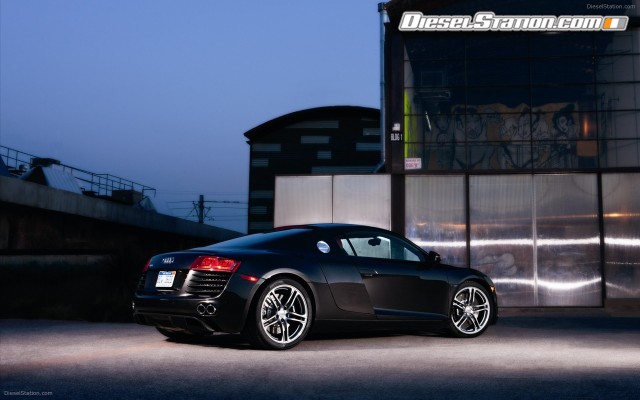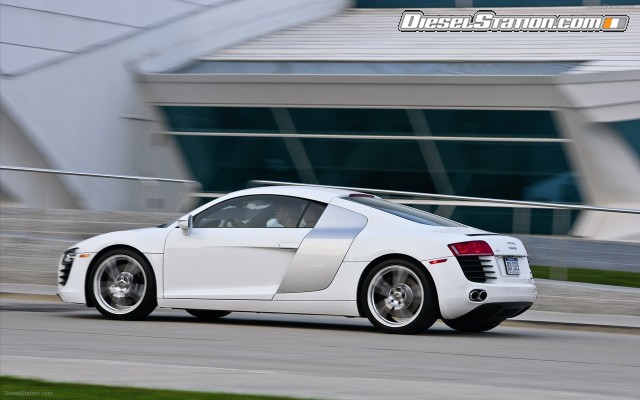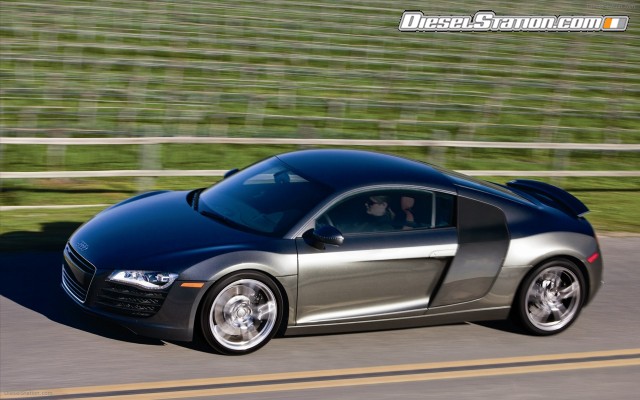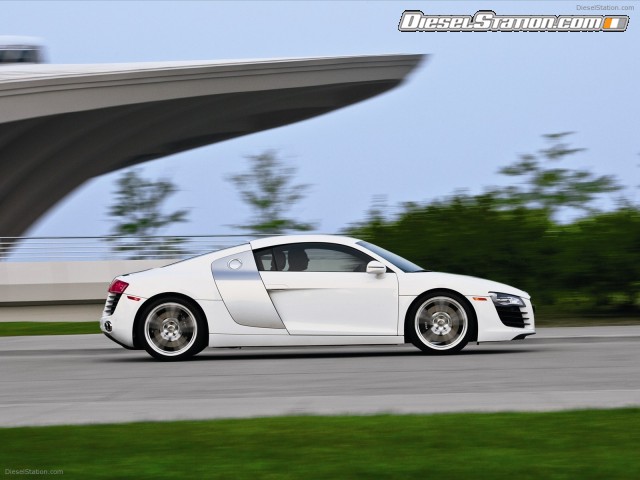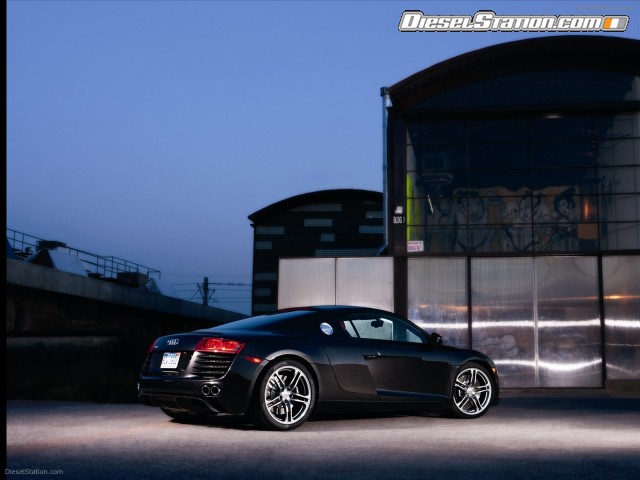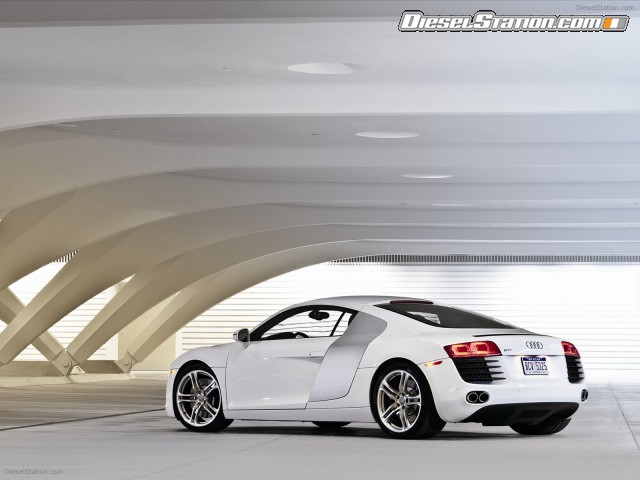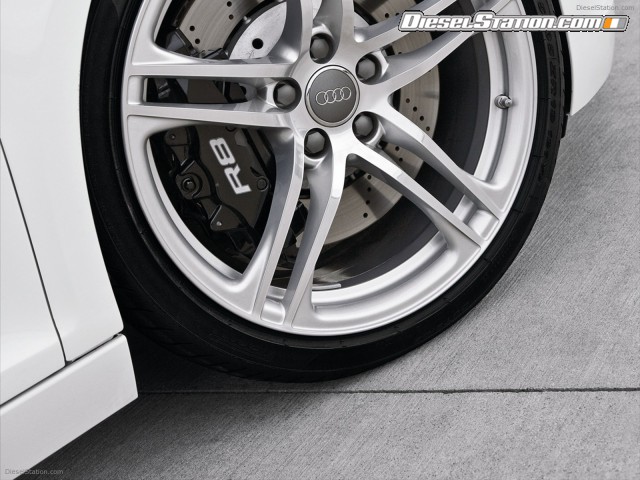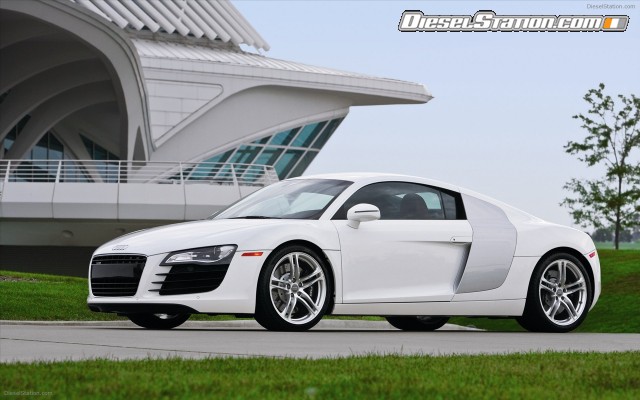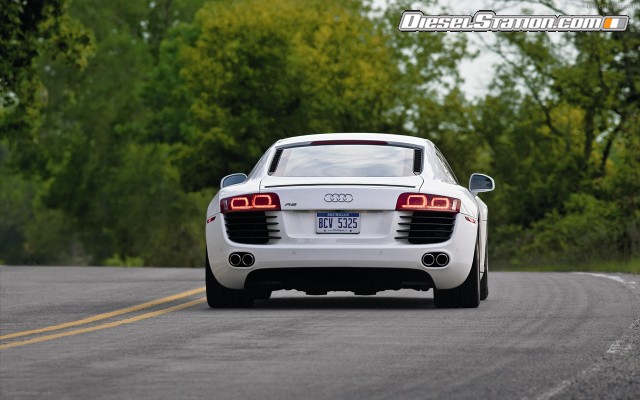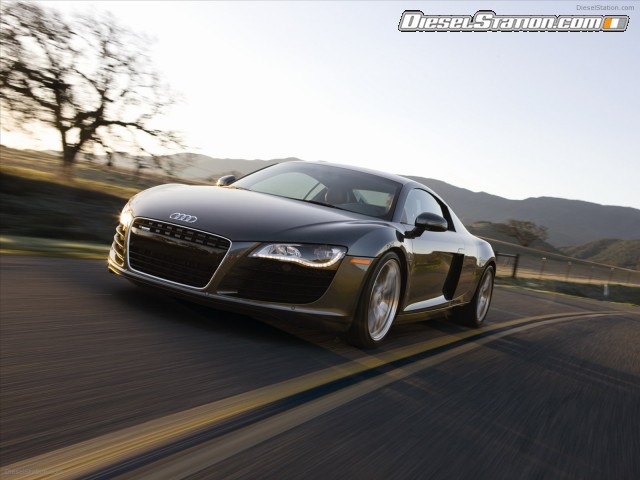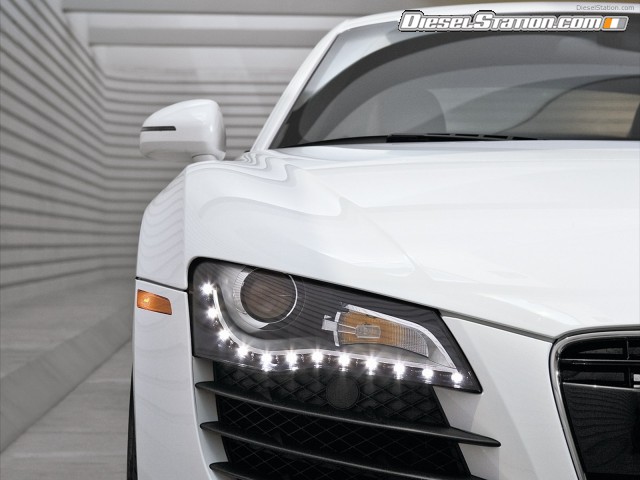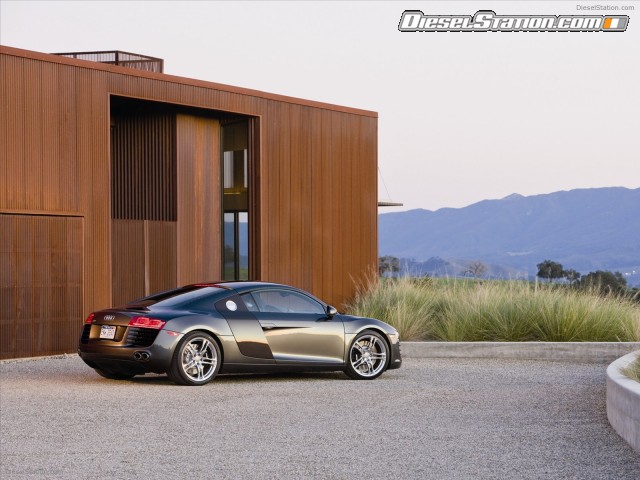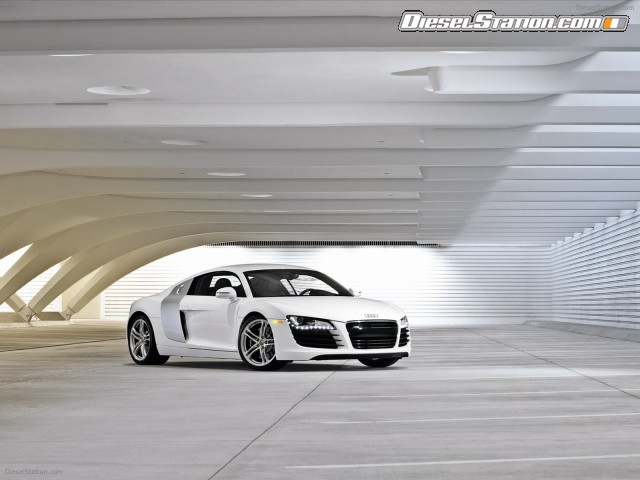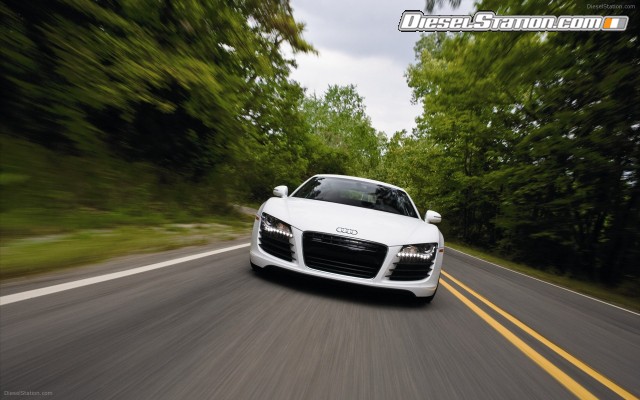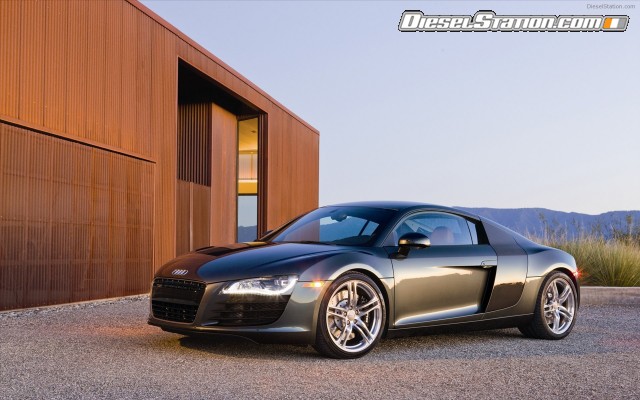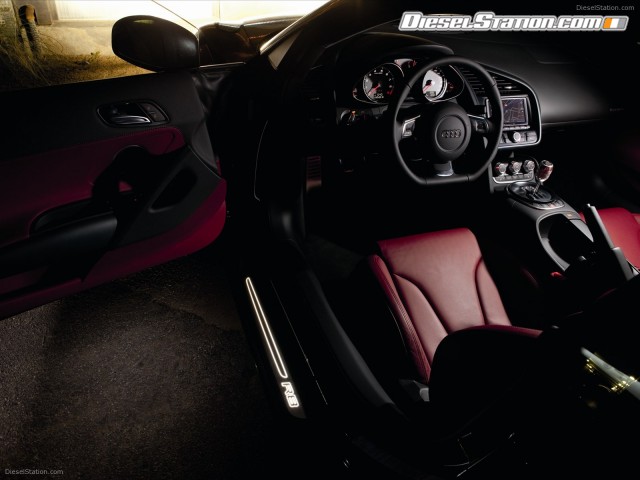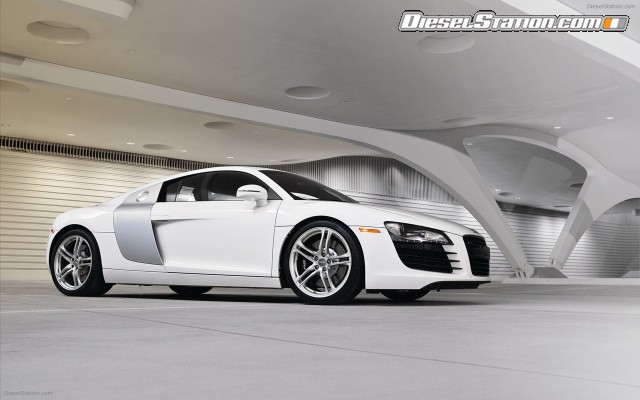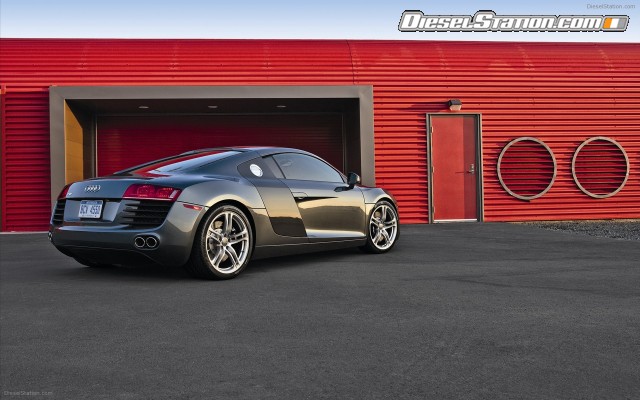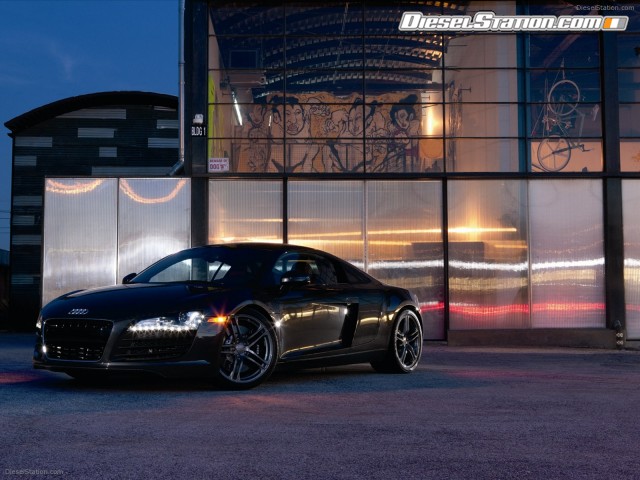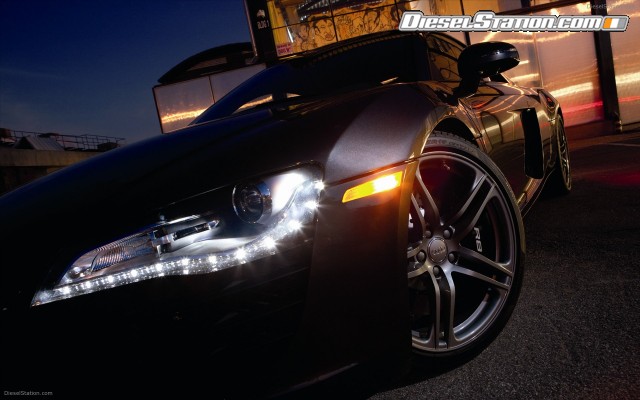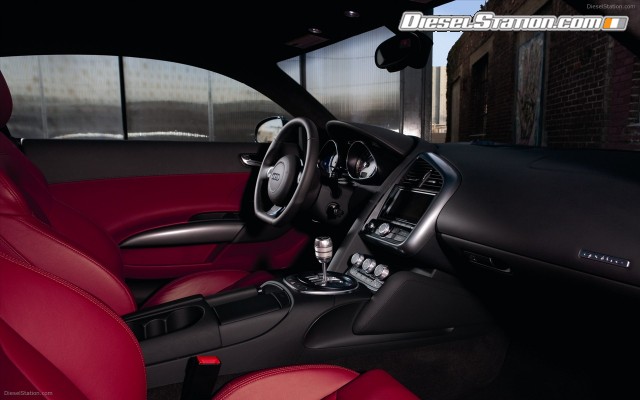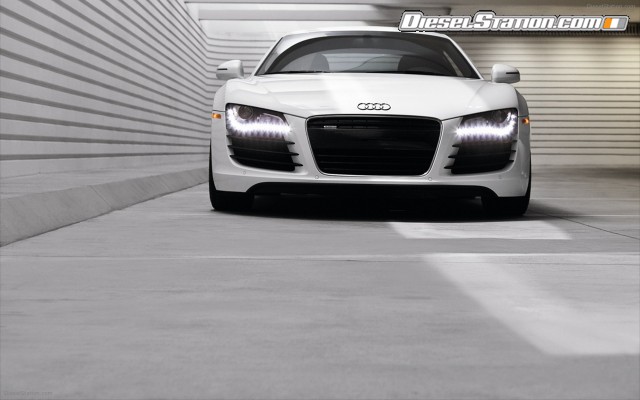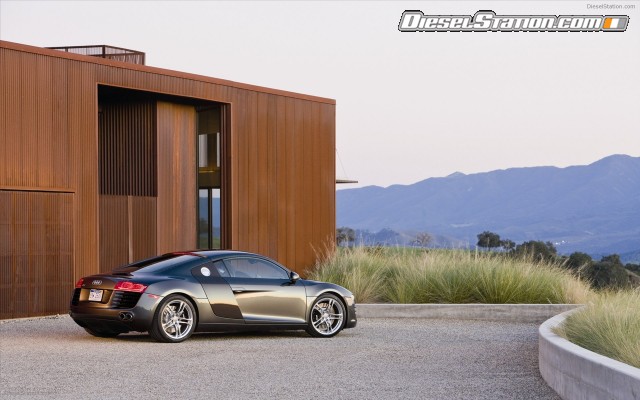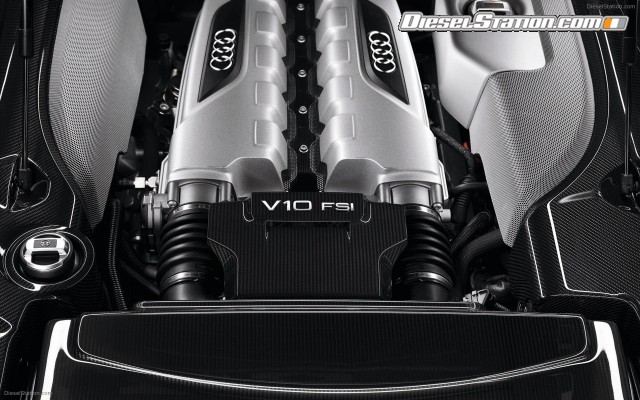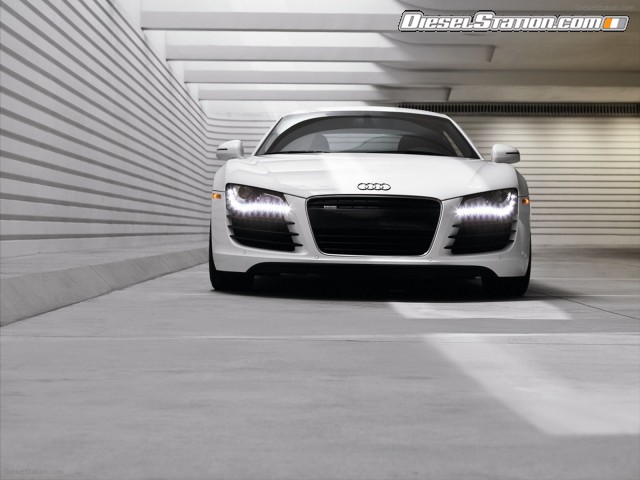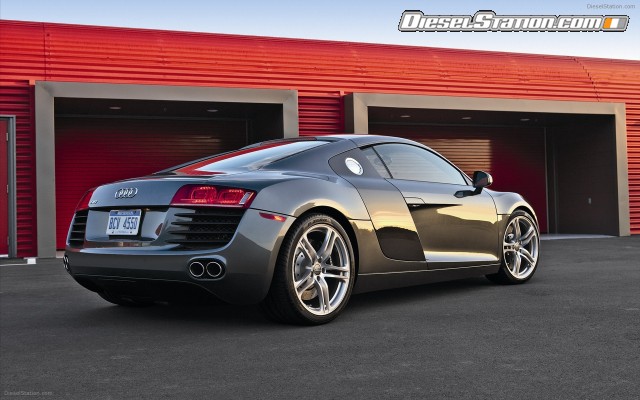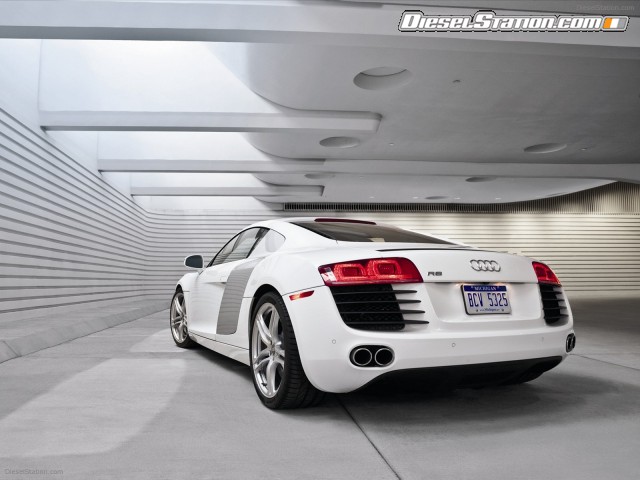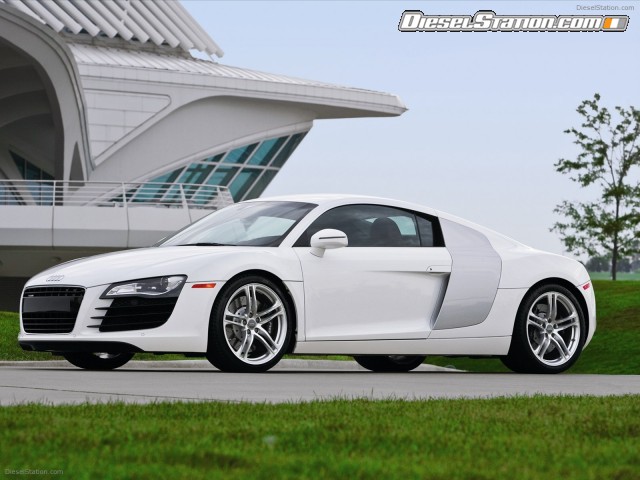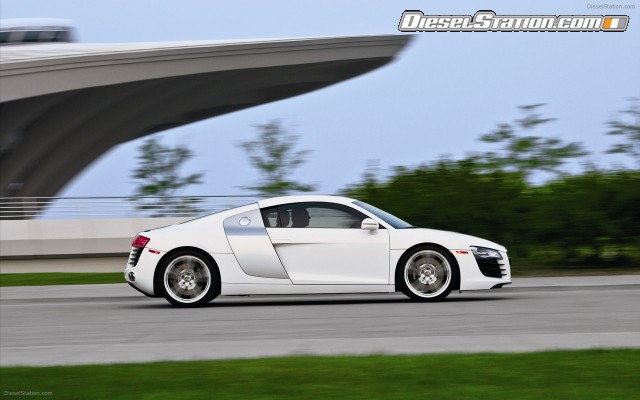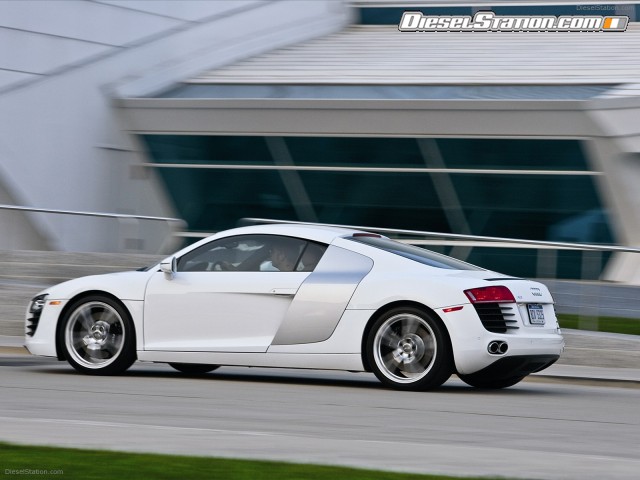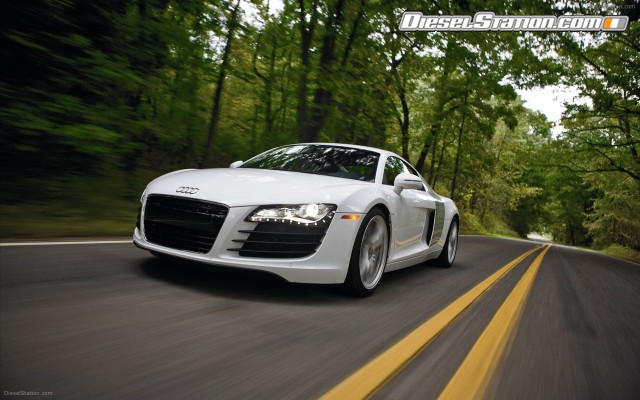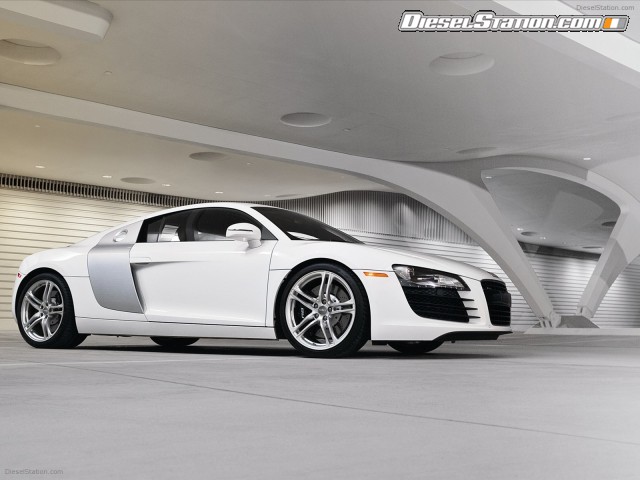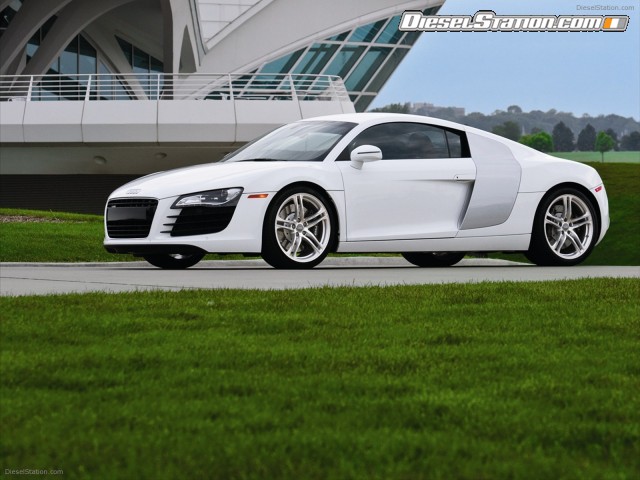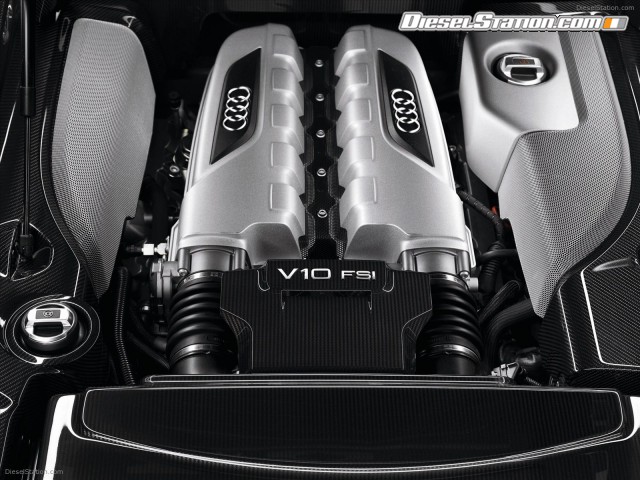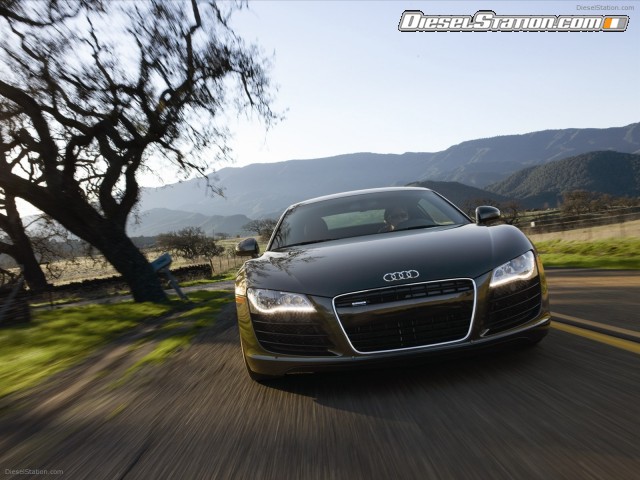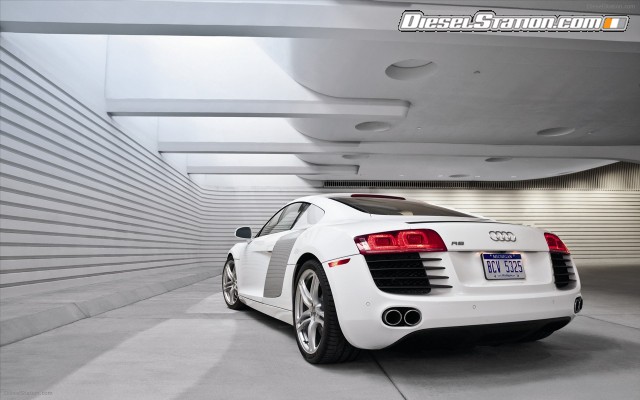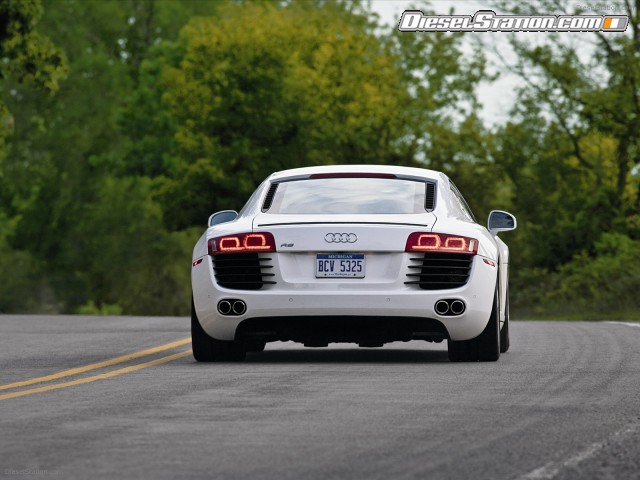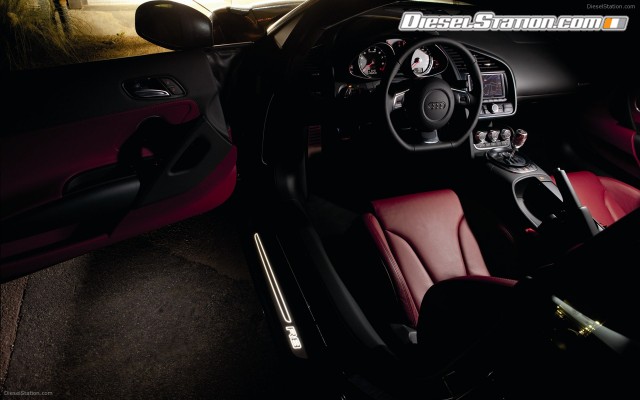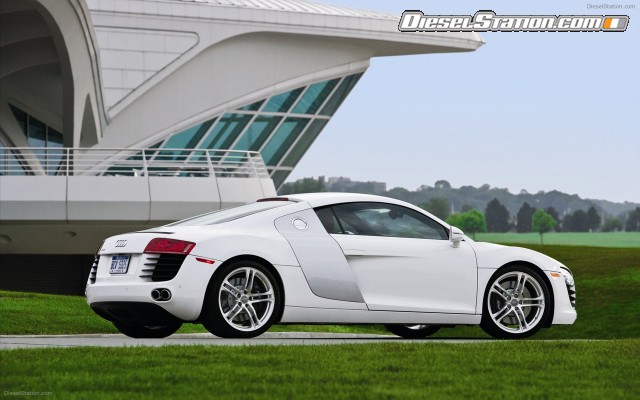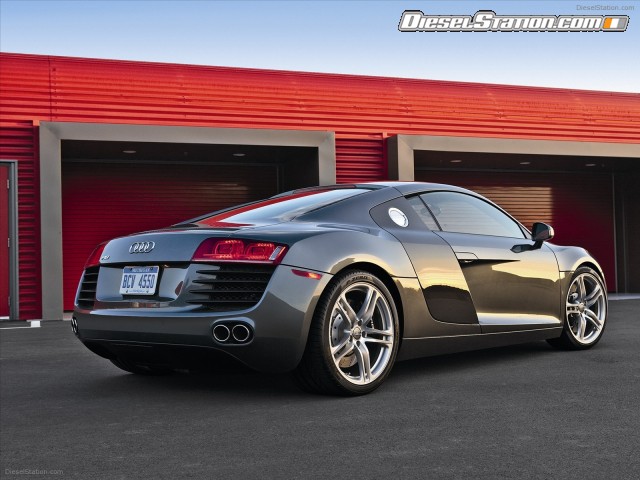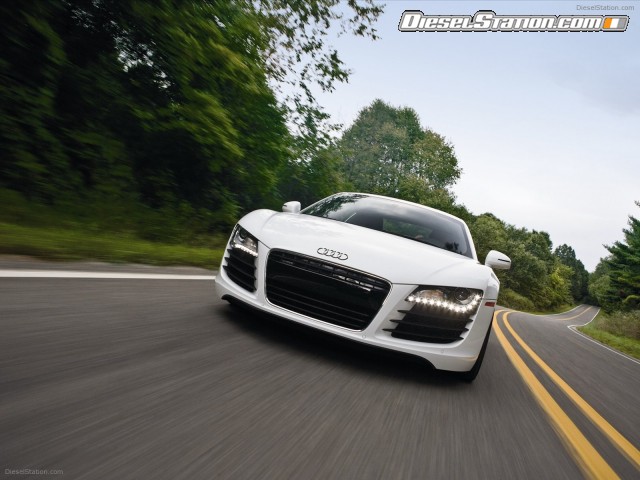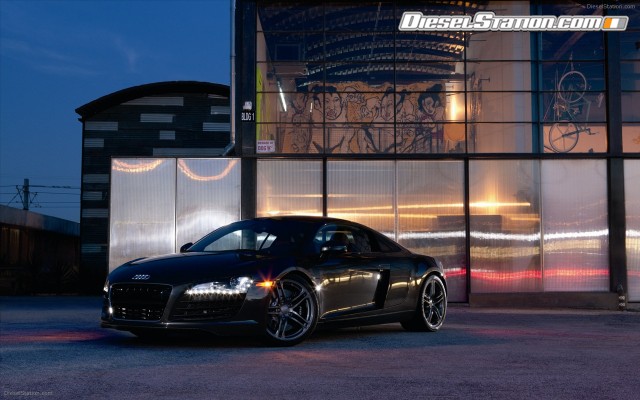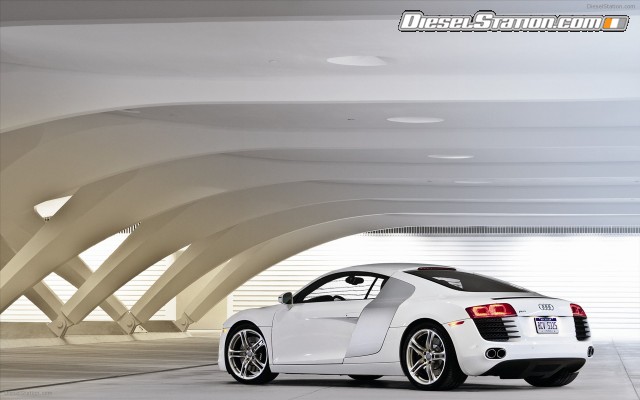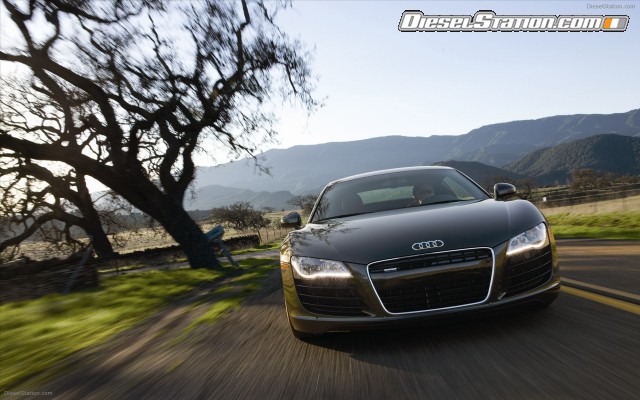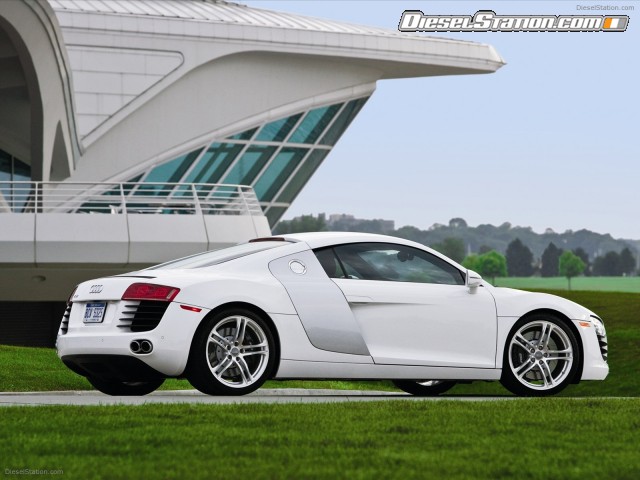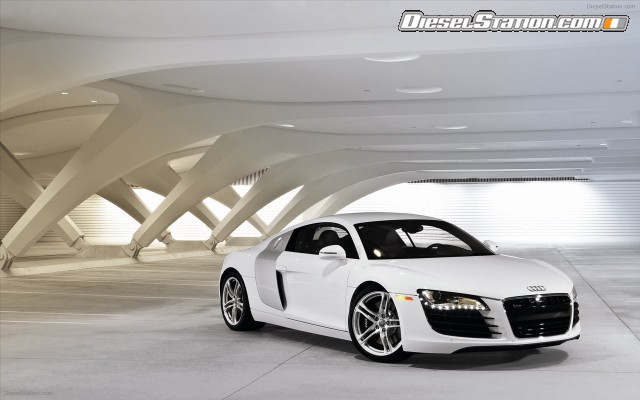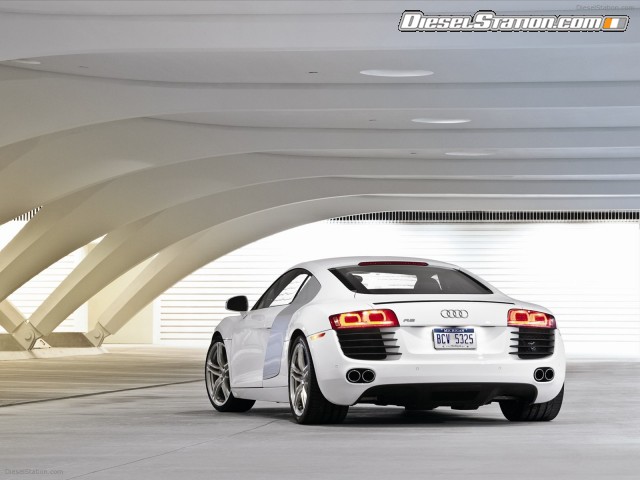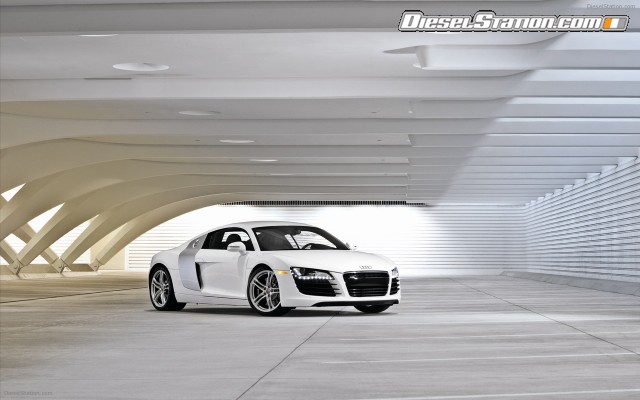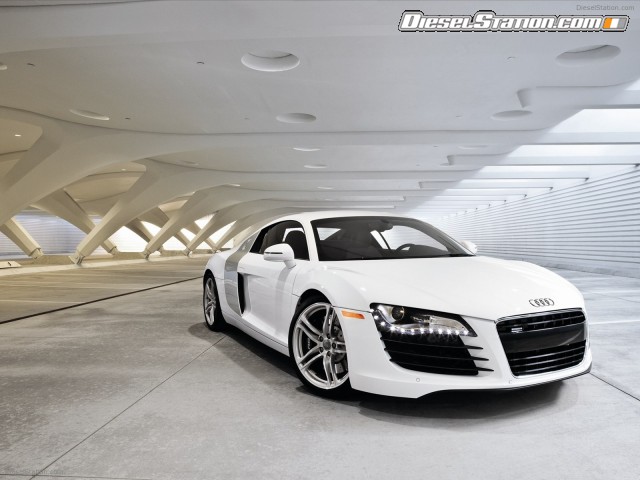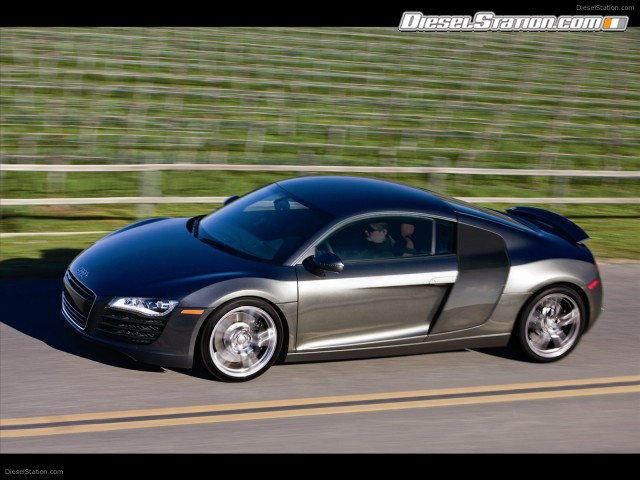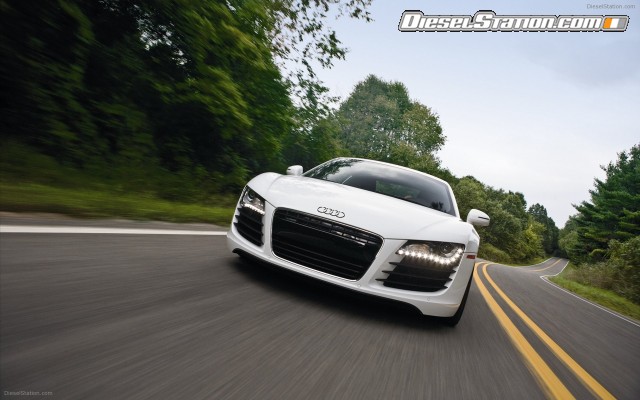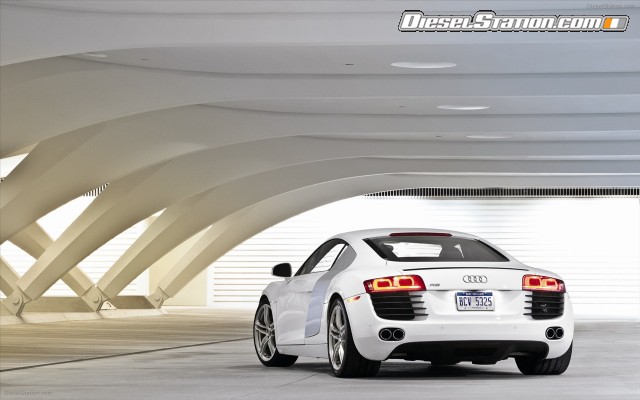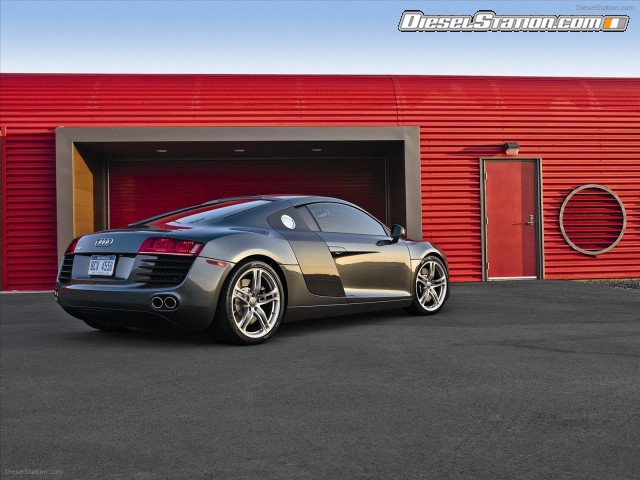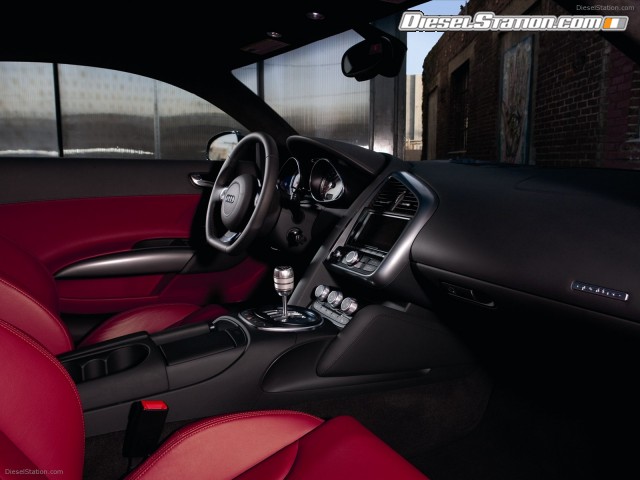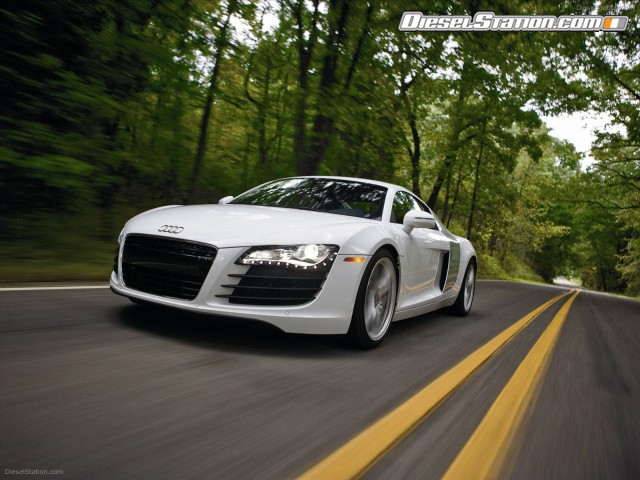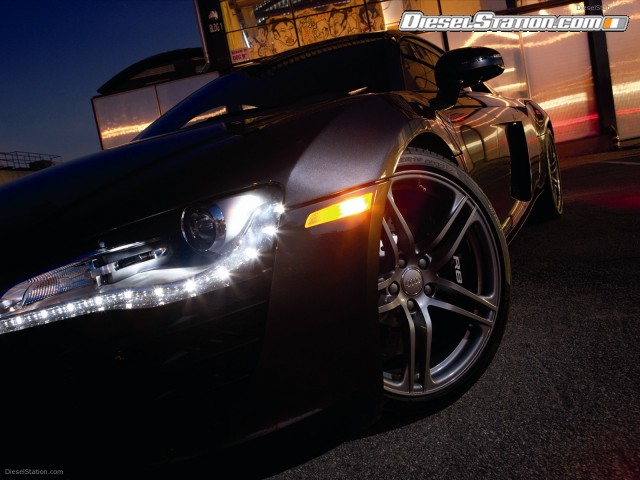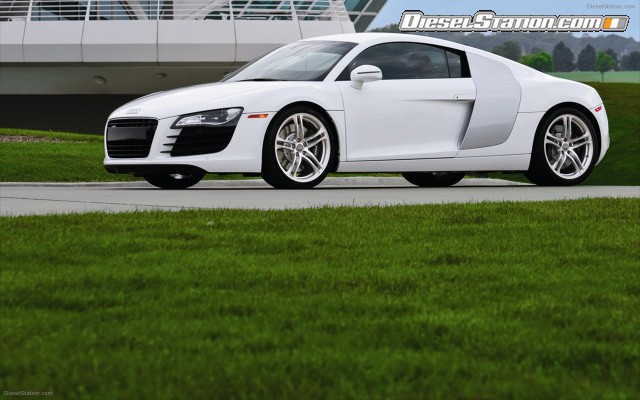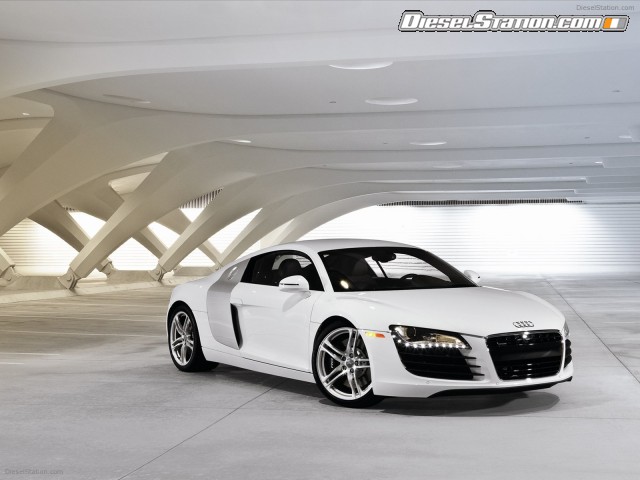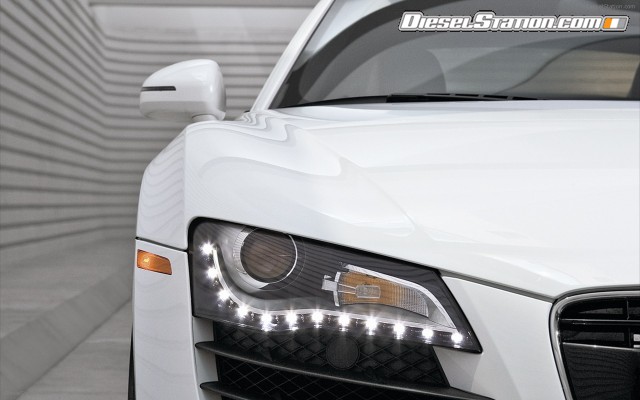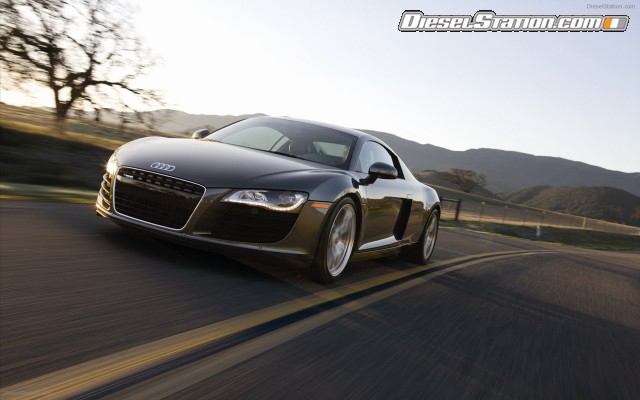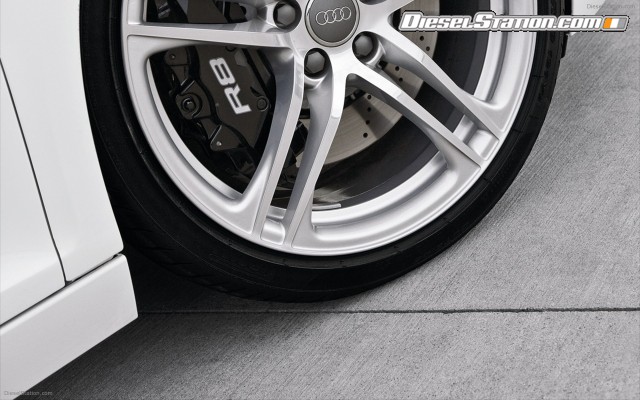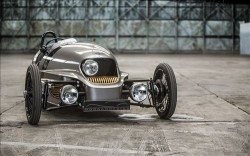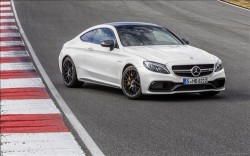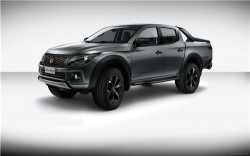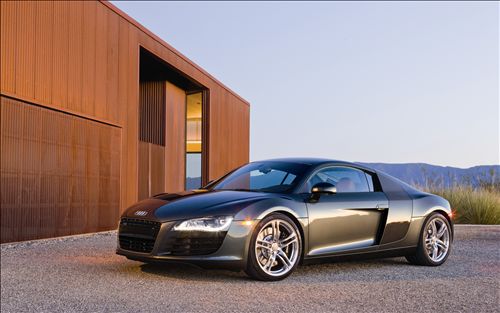Audi is expanding the model range of its R8 high-performance sports car, with another open-top version equipped with a V8 engine joining the R8 Spyder 5.2 FSI quattro. The 4.2-liter FSI produces 316 kW (430 hp) and launches the two-seater to 100 km/h (62.14 mph) in 4.8 seconds on its way to a top speed of 300 km/h (186.41 mph).
The Audi R8 Spyder 4.2 FSI quattro is pure high tech. The quattro permanent all-wheel drive gives it superior traction, and there is an option for the R tronic sequential manual transmission. The open body is an Audi Space Frame (ASF) made of aluminum and also features large-area components of carbon fiber composite material. The lightweight cloth top has a fully automatic drive. Audi-typical fit and finish, excellent everyday practicality and the brand’s optional high-end technologies – from LED headlights to seat belt microphones – round out the profile of the model athlete.
Design
The R8 Spyder 4.2 FSI quattro is hunkered down low and wide on the road, as if ready to leap. It is 4.43 meters (14.53 ft) long, with a wheelbase of 2.65 meters (8.69 ft), 1.90 meters (6.23 ft) wide, but only 1.24 meters (4.07 ft) in height. The dynamic proportions and the sculptural design give the mid-engine concept a powerful visual expression. The passenger cell is shifted far to the front; the windshield is low. The large vertical air intakes are athletically sculpted out of the flanks, and the shadow contour of the rear end forms a strong, flowing wave above the wheels.
An elliptical crease structures the long back of the R8 Spyder 4.2 FSI quattro and visually combines the passenger compartment and the engine into a single unit. The large arc encloses two large cowls in a shining silver aluminum-look material. They taper rearward from the bulkhead, and each includes six integrated air vents. Another wide discharge vent is located between the cowls. The exposed fuel tank cap of solid aluminum in the right side wall is an Audi style element.
The wide and low single-frame grille of the R8 Spyder 4.2 FSI quattro is painted in high-gloss black. The headlights are technical works of art – this applies to both the standard xenon plus units and the optional LED headlights, which use light-emitting diodes for all lighting functions. One of Audi’s greatest innovations, the LED light has a color temperature similar to that of daylight, making it easier on the eyes when driving at night. It also impresses with a long service life and extremely low energy consumption.
Regardless of the technology used for the headlights, the tail lights of the R8 Spyder 4.2 FSI quattro utilize LED technology. The dual-branch exhaust system ends in four tailpipes. The rear spoiler extends automatically at 100 km/h (62.14 mph) and together with the fully lined underbody generates downforce that presses the high-performance sports car firmly to the road. With a cD value of 0.36 with the top closed and the small front surface area of 1.99 m2 (21.42 sq ft), however, the two-seater still glides easily through the wind.
Audi offers the open high-performance sports car with a choice of three colors for the top: black, red and brown. The body is available in the solid finishes Ibis White and Brilliant Red; the metallic finishes Suzuka Gray, Teak Brown, Ice Silver, Jet Blue and Aurum Beige; and the pearl effect finishes Daytona Gray, Lava Gray and Phantom Black. The windshield frame sports an elegant application of anodized aluminum.
Body
Equipped with a manual transmission but without a driver, the R8 Spyder 4.2 FSI quattro weighs in at only 1,660 kilograms (3,660 lb), and just five kilograms (11.02 lb) more with the R tronic. The decisive factor for this low weight is the aluminum body, which features an Audi Space Frame (ASF) design.
The body in white is comprised of three wrought components: extruded aluminum sections comprise 75 percent; nodes make up 8 percent; and the aluminum panels that are integrated into this skeleton with friction connections make up the remaining 17 percent.
The body is largely assembled by hand with the utmost precision at the production shop at the Neckarsulm site.
The open superstructure is specially reinforced in the area of the center tunnel, the sills, the rear bulkhead, the floor and both the A- and B-pillars, yet still only weighs 216 kilograms (476 lb), just 6 kilograms (13.23 lb) more than in the coupe. The high stiffness of the ASF body provides the basis for the dynamic handling, superior crash safety and high vibrational comfort of the Audi R8 Spyder. The body is tops in its segment in terms of lightweight quality – the relationship between weight, size and torsional stiffness.
The body concept of the Audi R8 Spyder 4.2 FSI quattro demonstrates the expertise with which Audi combines pioneering lightweight materials. The co-supporting engine frame is made of ultra-lightweight magnesium. The rear side panels of the open-top two-seater are made of ultra-lightweight carbon fiber composite material (CFRP), as is the large cover over the roof compartment.
A new method called resin transfer molding (RTM) is used to produce the CFRP components. In addition to being faster and more energy-efficient than conventional production in an autoclave, RTM also yields superior surface quality. The carbon fiber composite components reduce the weight by up to 60 percent over conventional steel components and also permit substantial design freedom.
Convertible top
The R8 Spyder 4.2 FSI quattro has a lightweight cloth roof – a typical Audi solution and without compromise for a high-performance sports car. The soft top’s approximate weight is a mere 42 kilograms (93 lb) and keeps the vehicle’s weight and center of gravity low. It fits harmoniously into the design line when up. It tapers off to two long, slim fins that extend to the trailing edge of the car and have an elongated contour similar to the fixed roof of the R8 Coupé.
The outer skin of the top is a leakproof textile fabric. A headliner covers the frame, large portions of which are made of ultra-light die-cast magnesium and aluminum.
The soft top is fully suitable for high-speed driving up to the top speed of 300 km/h (186.41 mph), and is very comfortable acoustically. When driving at moderate highway speeds with the top up, interior noise levels in the R8 Spyder are barely higher than in the Coupé.
The cloth top has an electrohydraulic drive. A system of actuating cylinders, hinges and hooks opens and closes the top in 19 seconds, even while driving at speeds up to 50 km/h (31.07 mph). When opened, the 1.7 square meters (18.3 sq ft) of fabric folds in a Z-shape into its shallow storage compartment over the engine. The CFRP compartment cover moves on two seven-joint hinges. The mechanical interaction of the two components is a pleasure to watch.
The heated glass window is separate from the cloth top and integrated into the bulkhead between the passenger and the engine compartments. The heated window can be raised and lowered by operating a switch, regardless of whether the soft top is open or closed. A wind deflector comes standard. It latches into the bulkhead behind the seats in two steps and keeps the cabin as good as draft-free at speeds of up to roughly 200 km/h (124.27 mph).
Recessed in the bulkhead is a rollover protection system comprising two strong, spring-loaded sections that shoot up within 0.2 seconds in the event of a pending rollover. In the event of a side impact, head/thorax side airbags in the backrests protect the passengers. Full-size airbags stand at the ready in the event of a head-on collision. In a rear-end collision, the integral Audi head restraint system reduces the risk of whiplash injuries.
The top forms a premounted assembly together with the rollover protection system, the rear window, the storage compartment and the cover. It is inserted as a block into the ASF body during assembly of the R8 Spyder, lending the body additional stiffness.
Interior
The interior of the Audi R8 Spyder 4.2 FSI quattro is comfortably spacious. The sport seats with their pronounced side bolsters offer the ideal seating position for drivers and passengers of any size. The rim of the leather multifunction sport steering wheel is flattened at the bottom. Slender A-pillars provide a large diagonal field of view to the front. Another major plus in daily use is the luggage compartment, which offers room for 100 liters (3.53 cu ft) in a compartment under the hood. A practical storage box is located behind the seats. Three bins lit by LEDs can hold CDs and other frequently needed items.
A large arc, the “monoposto,” encircles the interior, which is sharply angled toward the driver. The controls are clear and simply structured; the large dial instruments can be easily read at a glance. The driver information system integrates a lap timer for recording circuit times. The automatic air conditioning has been specially tailored for the conditions of open-top driving.
The interior is largely clad in a sportily cool black; many controls shine in an aluminum-look material, and the bezels sport a matt black satin-finish coating. As with every Audi, the use and workmanship of all materials is subject to uncompromising quality standards. This can be seen and felt in every tiny detail.
Engine
The free-breathing 4.2 FSI is a high-performance engine. It produces 316 kW (430 hp) from a displacement of 4,163 cc, or 75.9 kW (103.3 hp) per liter of displacement. Its rated engine speed is 7,900 rpm, and the rev limiter kicks in at 8,250 rpm. The V8 delivers 430 Nm (317.15 lb-ft) of torque between 4,500 and 6,000 rpm, with at least 90 percent of peak torque available between 3,500 and 7,500 rpm. The high-revving V8 delivers an experience that appeals to all of the senses – with spontaneous and tenacious throttle response, with its easy revving, with hefty torque and sonorous, voluminous music.
The 4.2 FSI accelerates the R8 Spyder from a standing start to 100 km/h in 4.8 seconds on its way to a top speed of 300 km/h (186.41 mph). Both values apply to both the manual transmission and the R tronic. When paired with the R tronic, the powerful V8 consumes only 13.5 liters of fuel per 100 km (17.42 US mpg) on average; fuel consumption with the manual transmission is 14.4 liters per 100 km (16.33 US mpg). The forced oil pump of the dry sump lubrication system features various suction and discharge stages for load-dependent operation. A recuperation system that recovers energy during braking and coasting phases is standard.
The compact V8, which is hand-assembled at the engine plant in Györ, Hungary, has the classic cylinder angle of 90 degrees and weighs just 216 kilograms (476 lb). Its crankcase is made of an aluminum-silicon alloy using the low-pressure die casting method, which ensures particular homogeneity. The high silicon content makes the cylinder barrels extremely resistant to wear.
A bedplate structure further improves the rigidity and vibration behavior of the crankcase. The cast iron bearing bridges reduce thermal expansion and thus keep the play at the main bearings of the crankshaft within tight limits. The forged crankshaft, the forged steel connecting rods and the forged aluminum pistons combine low weight with high strength. The dry sump lubrication system with its separate oil tank enables the engine to be installed very low in the vehicle while also ensuring the supply of oil to the engine even under extreme lateral acceleration.
Fuel is supplied to the engine by a common rail unit – FSI direct gasoline injection is typical for Audi. Injected at up to 120 bar of pressure, the fuel mixture is swirled intensely in the combustion chambers and thus cools the walls. This allows a high compression of 12.5:1, which benefits the development of power and efficiency. Four camshafts, which can be adjusted through 42 degrees of crankshaft angle, actuate the 32 valves. Zero-maintenance chains on the back of the engine drive the camshafts and the ancillaries.
The air flows through straight aluminum velocity stacks 23 centimeters (9.06 in) in length integrated into the dual intake system. The intake plenum is made of lightweight plastic. Vacuum-actuated flaps are integrated into the intake ports. Controlled by the engine management system, they cause the air to move with a roller-like rotation. This “tumble” further enhances combustion quality.
The exhaust system is also a dual-branch system. Its components and the pipes of the manifold are very light and have been designed for low backpressure. Exhaust flaps in both tailpipes open at higher load and engine speed for an even fuller sound.
Drivetrain
The Audi R8 Spyder 4.2 FSI quattro rolls out of the Neckarsulm production shop with a standard-fit manual six-speed transmission. This works together with a compact dual-disc clutch and as is typical for Audi can be shifted extremely precisely and easily with short throws. The shift lever is made of polished aluminum, the open gate of stainless steel.
Audi offers the high-efficiency R tronic sequential six-speed transmission as an option. Shift commands are transmitted electrically; a hydraulic system changes the gears and manages the clutch. The R tronic offers both an automatic and a manual mode, both of which allow the driver to choose between two shift programs.
In manual mode, the driver controls things using the joystick on the center tunnel or with the paddles on the steering wheel. At high load and engine speed, gear changes take just one-tenth of a second. The Launch Control program provides for extremely fast starts. It controls the engine speed and the engagement of the clutch to accelerate the open-top two-seater with the ideal wheel slip.
The quattro permanent all-wheel drive system sends the power from the engine to all four wheels with supreme ease. It provides that decisive bit of additional stability, cornering speed, precision and grip that allows the R8 Spyder to pull away from the competition. The four powered wheels seem to claw into the asphalt at the exit of the corner, and the driver can get back on the throttle sooner than in a car with rear-wheel drive.
Due to the mid-engine layout, the quattro all-wheel drive system in the R8 Spyder features a special layout and was designed with a strong rear bias. The transmission, which is mounted behind the longitudinal V8, has an auxiliary drive for a cardan shaft running past the engine to the front axle, where a viscous coupling distributes the torque.
During normal driving, the coupling sends roughly 15 percent of the torque to the front wheels, 85 percent to the rear wheels. If they begin to spin, an additional 15 percent quickly flows to the front. A locking differential at the rear axle further boosts dynamics. It provides up to 25 percent lockup when accelerating and up to 45 percent when coasting. If a wheel on one of the axles should slip, it is braked by the EDL electronic differential lock.
Chassis
The R8 Spyder 4.2 FSI quattro is an integrated system of speed. Audi has seamlessly embedded its fascinating emotions in perfect technical expertise. The open-top high-performance sports car steers spontaneously, almost reflexively, into corners and takes them with supreme composure. Its handling limits are very high and easily managed. The hydraulic rack-and-pinion steering connects the driver intimately with the road and features a sporty and direct 16.3:1 ratio.
The axle load distribution of the Audi R8 Spyder 4.2 FSI is 44 to 56 percent; the track measures 1.64 meters (64.57 in) up front and 1.60 meters (62.99 in) at the rear. As with a race car, the wheels are located by double wishbones made of aluminum.
Their rubber-metal bearings divert the lateral forces precisely into the rigid ASF body while at the same time ensuring high longitudinal elasticity. The setup provides for good comfort in everyday driving. Audi also offers a taut, dedicated sport suspension as an option.
Another option is Audi magnetic ride adaptive damping. It uses magnetic fields in the oil of the shock absorbers to adjust their response to road conditions within milliseconds and adapt to the driver’s style. There is a choice of two basic characteristics. During fast cornering and when braking, the control unit reduces body pitch and roll through the targeted increase of damping force at the individual wheels.
The R8 Spyder 4.2 FSI quattro rolls on 18-inch wheels. The front tires measure 235/40, the rear tires 285/35. A tire pressure indicator is standard. Audi offers optional 19-inch wheels in a variety of designs – monochrome or two colors, polished or even in a fine titanium look.
Behind the wheels are powerful disc brakes measuring 365 millimeters (14.37 in) in diameter up front and 356 millimeters (14.02 in) at the back. They are vented, drilled and composed of two pieces – stainless steel pins connect the steel friction rings to the aluminum caps. This complex concept enables the brakes to dissipate heat quickly. Eight-piston calipers painted black grab the front discs, while four-piston calipers clamp down on the rear discs. The 19-inch wheels are optionally available with drilled carbon fiber-ceramic discs that are extremely lightweight, robust, long-lived and corrosion-free.
The ESP electronic stabilization program of the open-top high-performance sports car features a special design. By pressing a button, the driver can activate a sport mode that permits spectacular but safe oversteer when the gas is applied while exiting a corner. The ESP and the anti-slip control function can also be completely deactivated for particularly dynamic driving situations, such as a trip to the race track.
Equipment and trim
The Audi R8 Spyder 4.2 FSI quattro comes with a generous array of standard equipment. Among the highlights are metallic paint, aluminum door sill trims, the concert radio system with seven speakers, the xenon plus headlights, the LED tail lights, the deluxe automatic air conditioning system, the alarm system, the automatic top, the rollover protection system and the wind deflector. The Fine Nappa leather seats can be heated in cold weather. Special color pigments in the seat covers reflect the infrared component of light and help to minimize the extent to which they heat up in the sunshine.
Audi also offers a list of upscale optional equipment. This includes power-adjustable seats, the hill-start assist, cruise control, the interior lighting package with LED lights, the storage package, the LED headlights and the high-beam assistant. The R tronic automatic transmission, the ceramic disc brakes, the 19-inch wheels and the sport suspension or the Audi magnetic ride shock absorber system make driving even more dynamic.
Multimedia options include an excellent sound system from Bang & Olufsen with 465 watts of power, the Audi music interface for easily connecting a mobile player, a CD changer and a Bluetooth cellular phone preparation kit. The navigation system plus is characterized by its MMI operating logic and a high-resolution 6.5-inch display. It can be combined with a reversing camera for easy parking.
An enticing innovation from Audi is the seat belt microphone for the hands-free unit and the speech dialogue system, which makes it possible to talk on the phone even with the top down on the highway. Integrated into both seatbelts are three small, flat microphones. At least one of them is ideally positioned relative to the speaker when the belt is on. There is a fourth microphone in the windshield frame.
Audi offers the extreme individualists among its customers the choice from a wealth of exclusive options, the lion’s share of which are provided by quattro GmbH. These include leather in a wide variety of colors and grades, aluminum-look pedals, the carbon packages for the exterior, inlays in carbon and black piano lacquer, Alcantara for the headliner and the lining of the luggage compartment, the bucket seats and the custom luggage set.
The R8 Spyder 4.2 FSI quattro will soon be rolling into German showrooms with a base price of €121,100.
Image Copyright: Audi
Audi R8 (V8) 4.2 FSI quattro 2011
DieselStation Social




